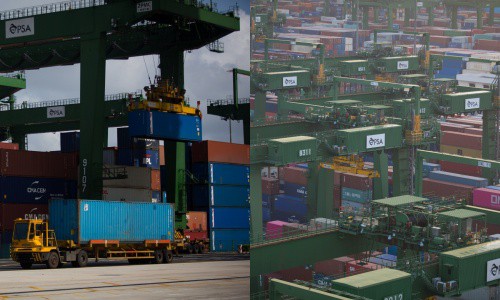As part of the smart grid management system (SGMS) project at Singapore’s ports, the city’s first energy storage system (ESS) has been deployed at the Pasir Panjang Terminal and will be operational in the third quarter of this year.
The ESS will contribute to helping the SGMS to improve the energy efficiency of port operations by 2.5%. It will also reduce the port’s carbon footprint by 1,000 tCO2e per annum, the equivalent of removing around 300 cars off the road annually.
“Electricity demand will grow in the next decade with increasing electrification. The adoption of innovative demand-side technologies such as smart energy management systems and energy storage systems will help us optimise our energy supply and power grid capabilities,” said Ms Jeanette Lim, director of the industry development department at the Energy Market Authority (EMA).

She added that innovative digital solutions such as this project will play a part in making Singapore’s energy systems more efficient and resilient.
The SGMS project is part of the S$8 million partnership between the EMA and PSA Corporation (PSA) to transform PSA’s energy usage in port operations through the use of smart grid technologies and energy management systems. A consortium led by Envision Digital has been tapped for the project, which also includes the installation of solar panels.
The EMA-PSA partnership is part of EMA’s Accelerating Energy Storage for Singapore (ACCESS) programme to facilitate ESS adoption in Singapore by promoting use cases and business models. This project will also go towards supporting EMA’s target of deploying at least 200 MW of ESS beyond 2025.
Real-time automated forecasts
With the dynamic nature of port activities, energy demand can fluctuate throughout the day. Port operations involve the use of energy-intensive equipment such as cranes and prime movers. Due to the dynamic nature of port activities, the energy demand can fluctuate throughout the day.
The ESS is managed by the EnOSTM platform uses machine learning to provide real-time automated forecasts of the terminal’s energy demand. This enables long-term planning of port assets, short-term scheduling and real-time energy management within the Pasir Panjang Terminal to reduce overall energy costs and carbon footprint.
Whenever there is a forecasted surge in energy consumption, the 2 megawatt/2 megawatt-hour battery ESS is activated to supply energy to help meet demand. With this enhancement to Pasir Panjang Terminal, spikes in energy demand of the port will be minimised.

“As a premier hub port driving innovation, digitalisation and sustainability, PSA can play an active role in contributing and co-creating Singapore’s smart grid architecture and energy systems. We are excited to partner EMA in unlocking the full potential of battery energy storage solutions to achieve cleaner and more efficient energy for our operations. As PSA enhances efficiency with port automation, we will continue to drive collaborative innovation with our partners for greater resilience in our energy future,” said Alvin Foo, head of new technologies and sustainability at PSA.
Meanwhile, at times when the ESS is not being used at the terminal, it will participate in the National Electricity Market of Singapore to provide ancillary services to the power grid and to generate revenue. Insights from the project may also validate the possibility for commercial and industrial users to adopt ESS to serve multiple purposes, such as demand management on-site and providing commercial ancillary services to support power systems.
Sustainable development journey
Tan Joo Hong, head of global ports solutions at Envision Digital said its collaboration with the PSA will result in a reference model for ports embarking on sustainable development journey.
“With energy, machines, and systems orchestration through the use of EnOSTM, our jointly developed SGMS solution will support PSA in its sustainable development initiatives such as large-scale electrification and enable better management capabilities when PSA adopt different green energy sources,” said Tan.
Insights from the SGMS can also be applied for advanced energy management and optimisation at the Tuas Port, which would be the world’s single largest fully automated terminal upon completion in the 2040s. For greater sustainability, retired batteries from port equipment such as automated guided vehicles can be repurposed into second-life ESS.



